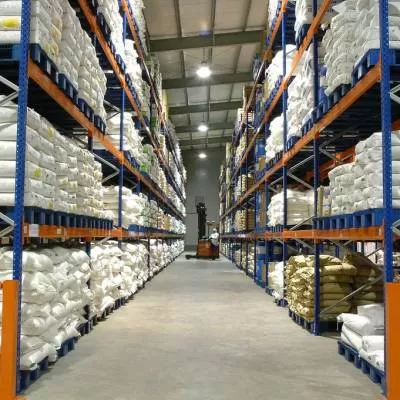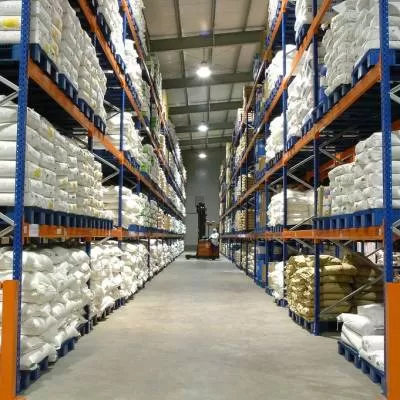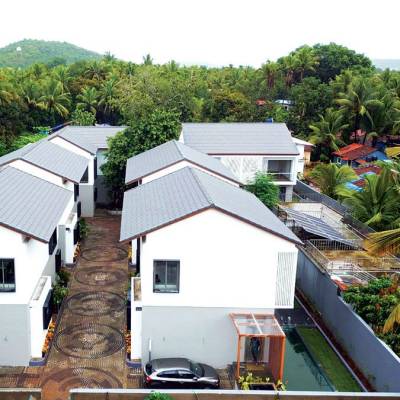- Home
- Infrastructure Urban
- WAREHOUSING & LOGISTICS
- Space to Grow

Space to Grow
Warehousing in India is enjoying a good run.
Demand grew from 919 million sq ft in 2014 to 1,023 million sq ft in 2015. Knight Frank Research projects demand to grow at 9 per cent per annum to touch 1,439 million sq ft in 2019.
Location, location, location
Like other real estate, warehousing is all about location. Some cities have it better. ´Delhi National Capital Region (26 per cent) and Mumbai (24 per cent) accounted for half the total space take-up in 2015, with Bengaluru (20 per cent) and Chennai (13 per cent) also coming on the radar of warehousing space occupiers,´ says Jasmine Singh, Head, Industrial & Logistics Services, CBRE South Asia Pvt Ltd.
´Mumbai and Delhi are the top two locations, followed by Chennai, Bengaluru and Pune,´ says Nirav Kothary, National Director, Industrial Services, JLL India. This trend is largely expected to continue in 2016.
´Delhi NCR and Mumbai can each expect to enjoy 20 per cent of the demand for warehousing space; Ahmedabad, Bengaluru, Pune, Chennai and Kolkata can each expect to bag 10-12 per cent of the demand, while Hyderabad will attract 6-7 per cent of the demand, according to Balbir Singh Khalsa, National Director, Industrial & LRG & Director, Ahmedabad, Knight Frank.
Drilling down to the sub-city level, some areas in these cities can expect to see higher growth. ´Warehousing locations such as Gurgaon in the NCR, Aslali and Changodar in Ahmedabad, Bhiwandi in Mumbai, the Western Corridor in Bengaluru, the Northern Corridor in Hyderabad, and the Western Belt in Chennai are likely to be in the forefront of leasing activity during 2016,´ shares Singh.
What may change if the proposed GST bill sees the light of day is a spill-over of demand for warehousing space to new locations, ´hidden gems,´ as Kothary calls them, cities offering supply chain advantages (instead of veering on cities where CST and VAT rates are lower). Among these, Kothary includes Vijayawada, Guwahati, Kanpur, Kolhapur, Nagpur, Coimbatore, Vapi, etc.
´Warehousing demand across select Tier-II cities is likely to improve and after work on the Smart Cities is completed, some of these are likely to emerge as prominent regional warehousing hubs: Ahmedabad, Visakhapatnam, Jaipur and Ludhiana,´ says Singh.
Watch out for Ahmedabad in the next three years, suggests Khalsa; also Tier-II and Tier-III cities, and capital cities of other states will see more warehouse leasing or acquisition activity owing to overall expansion.
Who´s occupying what?
Logistics, manufacturing and engineering, FMCG and e-commerce, in that order, were the biggest consumers of warehousing space in 2015, CBRE concluded. Logistics (3PL) companies like YCH Logistics, Redington India, Delhivery, DB Schenker and others lapped up close to 2.9 million sq ft of space. Engineering and manufacturing companies occupied close to 1.7 million sq ft.
Warehousing space can be categorised by quality as Grade A and Grade B, with the former being a top preference of e-commerce players.
´Almost a fourth of the superior quality Grade A warehousing space is in the e-commerce kitty,´ says Kothary.
´Demand has been increasing for high-quality large spaces, greater than 100,000 sq ft to 200,000 sq ft, and housed in a single shed,´ says Khalsa.
During 2015, close to 20 per cent of total demand in the leading cities was for warehousing space sized at 100,000 sq ft and above, while close to 25 per cent of leasing activity was for warehousing units between 50,000 sq ft and 100,000 sq ft, according to Singh.
Of future takers and popular spaces
All kinds of warehousing spaces are expected to see growth. ´Expect demand for premium and good-quality warehousing space to continue for three to five years. Grade B quality warehousing will also be in demand; in fact, it will enjoy consistent demand as it has a price advantage in rentals, which attracts the price-conscious SME sector,´ opines Khalsa.
Who might be big takers in future?
´With 100 per cent FDI approval for e-commerce coming through, more activity is expected in the near future. Currently, the sector is taking a ait-and-watch approach, but demand will be consistent in the near to medium term,´ opines Kothary. ´We expect e-commerce companies to take about a fifth of the net (additional) warehousing space in eight top cities this year,´ says Khalsa.
But Khalsa also expects some shakeup in e-commerce companies´ demand for space by city. For instance, Bengaluru has shown traction in the past two years as e-commerce players have taken up huge spaces. But as these take-ups will meet their immediate as well as near-term needs, the city may not see the same high level of demand from the sector. Instead, manufacturing, FMCG and retail will drive new growth in Bengaluru and elsewhere, according to him.
Healthy RoIs to drive investment
About Rs 15,000 crore is expected to be invested annually in acquiring land for warehouses and in their construction, according to Knight Frank.
´Investors in the warehousing space can expect an annual return of 12-20 per cent over the next five to 10 years, with the next three years being an especially exciting time for the sector mainly owing to the ´Make in India´ push by the government and the expected rollout of GST,´ says Khalsa.
´Warehousing investors can expect a RoI ranging between 7.5 per cent and 10 per cent,´ opines Kothary.
With customers demanding best global practices, assured service levels, professional expertise and cost-optimisation, established logistics players are likely to invest in moving their operations to a higher level of specialisation. ´Allcargo intends to establish logistics parks complying with design, safety, health, and environment norms in Mumbai, Delhi and Bengaluru, and warehouses built to suit the specific needs of the chemicals, retail, e-commerce, and food industries at strategic locations across India,´ shares Balaji V, COO-Contract & Ecommerce Logistics, Allcargo Logistics.
Real-estate companies in warehousing with land banks or deep pockets to acquire land may have an edge over logistics companies. Big developers who will start offering premium warehousing from this year onwards include the likes of Embassy, Assetz, IndoSpace, Casa Grande, ASV Constructions, etc. Each has a strategic interest in warehousing.
´Investing in warehousing structures is a dual-pronged strategy for realtors,´ says Bijay Agarwal, Managing Director, Salarpuria Sattva Group, which has shortlisted some locations where it will set up premium warehouses. ´Warehouses are constructed in the outskirts of cities and, as such, they become land banks of the future for real-estate companies. When the city expands, warehouses are converted into commercial and residential properties. In the meantime, warehouses generate healthy income during an upswing.´
Evidently, warehousing is on an upswing at the present time.
Quick Bytes
- Warehousing demand to grow at 9% per annum to touch 1,439 mn sq ft in 2019.
- Biggest consumers in 2015: Logistics, manufacturing and engineering, FMCG and e-commerce.
- Investors can expect 12-20 per cent annual return over next five to 10 years.
What ails warehouses in India?
An e-commerce player´s perspective
In conversation with CW, TK Balakumar, COO, Big Basket.com (India's largest online supermarket), which has about 15 warehouses in major metros and 17 more in smaller cities, outlines the company´s warehousing preferences and challenges:
Buy or lease: Your preferred option?
Leasing is our preferred modus operandi because as a start-up, we avoid huge spends on property and wish to retain the option of changing our storage locations as we grow.
Customisation: Is it relevant for warehouses?
About half our warehouses are build-to-suit (BTS) hires. This doesn´t entail constructing from scratch but we get the layout redone to suit our needs. BTS warehouses are always preferable but can take three to six months from the time of signing the lease agreement to be made ready to occupy, versus 30 to 60 days for warehouses leased as is (post minor modifications). Sometimes, the longer time lag can adversely impact business prospects, so we go with what can be made available the soonest.
What do you evaluate in a potential warehouse lease?
We match the available space with our need, the location with our preferred areas, the standard of the facility with our expectation, and the commercial aspect with our budget. We also look for ease of transportation to and fro and ease of accessibility for our employees.
What are the lacunae in warehouses in India?
Poor accessibility to the warehouse has been a challenge. Good roads in the vicinity of the property are essential for high productivity and to minimise breakages. As warehouses are on the outskirts of cities, sometimes the question arises as to whether the road falls outside the municipal limits and whether that would pose challenges for road repairs if need be.
Storm water drainage can be a concern given the value of inventory stored in the warehouse.
Lack of public transport to the warehouse makes it difficult for employees to commute.
Cost of constructing pre-engineered building warehouses
Pre-engineered buildings (PEBs) are a popular choice of warehouse developers and owners for their speed of construction, uncluttered column-less inner environment, and for being maintenance-free. ´Way back in the late 1990s, PEBs were first accepted as warehouses; thereafter, they caught up with industry and infrastructure,´ recollects Manish Garg, President, Steel Building Solutions, Everest Industries. Notable recent PEB warehouse leases in the NCR region, as per a CBRE report, include Suzuki Motor Corporation´s lease of 138,000 sq ft at Farukh Nagar on NH8, LG´s lease of 100,000 sq ft at Tikri, Delhi, and Snapdeal´s lease of 60,000 sq ft at Mundka, Delhi.
´Developing a build-to-suit (BTS) PEB warehouse can cost anywhere between Rs 500 and Rs 750 per sq ft, including civil works, PEB works and electrical works; depending on the functional specifications,´ says Garg. ´Controlled atmosphere (CA) PEB stores can cost approximately Rs 1,000 per sq ft to develop, while PEB cold stores typically cost between Rs 1,500 and Rs 2,000 per sq ft. CA stores and cold stores use different machinery. Their cost of construction depends on the capacity, floor loading, loading for pallets, gratings, etc.´
Impact of changing business norms on warehouse design
Warehouse design must aim to maximise the utility of available space and provide for orderly layout, safe product storage according to the hazard level of different product categories, safe and efficient warehouse operations, emergency handling and warehouse security, explains Balaji V, COO-Contract & Ecommerce Logistics, Allcargo Logistics Ltd, which provides warehousing services to major e-commerce players. Beyond these essentials, different industries mandate different types of infrastructure to meet regulatory and global compliance requirements.
Changing business norms impact warehouse design. For instance, in the e-commerce space, increasing demand for same-day delivery and the growing complexity of orders have led to massive investment in new technology, automation and newer designs for distribution centres. This trend mandates more storage space.
Hot prospects for cold stores
Growing at a compounded annual growth rate (CAGR) of 26 per cent in market value, the temperature-controlled warehousing market is likely to cross Rs 600,000 crore by 2017, according to ASSOCHAM. In capacity, the space is expected to grow at a CAGR of 13 per cent to touch 47 mt by 2017, from 35 mt in 2014.
About 40 per cent of this capacity lies in Uttar Pradesh with West Bengal ranked a distant second (23 per cent), followed by Punjab (5.5 per cent), Gujarat (5.2 per cent), Bihar (4.7 per cent), Andhra Pradesh (3.7 per cent), Madhya Pradesh (3.3 per cent), Maharashtra (2.2 per cent) and Karnataka (1.7 per cent).
Cold storages can be either single-produce stores or multipurpose.
´Eighty per cent to 85 per cent of existing cold storages in India are for a single agri produce like potatoes, applies, red chillies, etc,´ says Mahendra Swarup, President, Federation of Cold Storage Associations of India. He expects new facilities to come up in rural locations near the producing belts because high land acquisition cost in cities precludes such investments. ´Of late, we have seen the closure of several cold stores in Lucknow, because that land is more profitably used for real-estate development,´ he adds. ´A new cold store of 80,000 to 100,000 quintals capacity would cost Rs 5 crore excluding the land cost.´
Multipurpose cold storages account for a fourth of the existing cold store capacity but contribute just over half of the revenue, as per ASSOCHAM, which is contrary to Swarup´s views. He believes the scope for multipurpose cold storages is good even if they are currently facing hard times owing to low demand.
TCI has recently forayed into multipurpose temperature controlled warehousing, inaugurating its first state-of-the-art cold chain warehouse on Pataudi Road, Gurgaon, in the NCR region. ´The new facility will store grocery products, fruits and vegetables, pharmaceuticals, QSR, milk and dairy, marine and meat produce and specialty chemicals, as well as offer value-added services like cutting, dicing, mixing, packing and processing,´ says Jasjit Sethi, President & CEO, TCI Supply Chain Solutions.
´TCI plans to create a nationwide cold chain logistics network comprising five large-scale cold storage facilities by 2020, well supported by distribution and logistics services to provide customers with efficient, cost-effective solutions,´ says Vineet Agarwal, Managing Director, TCI Group.
- Charu Bahri
To share your views on the Warehousing market in India, write in at feedback@ConstructionWorld.in
- Investment
- CBRE South Asia Pvt Ltd
- Jasmine Singh
- Nirav Kothary
- JLL India
- Balbir Singh Khalsa
- Knight Frank
- GST
- FMCG
- E-commerce
- YCH Logistics
- Redington India
- Delhivery
- DB Schenker
- SME
- FDI
- RoI
- Construction
- Balaji V
- Allcargo Logistics
- Embassy
- Assetz
- IndoSpace
- Casa Grande
- ASV Constructions
- Salarpuria Sattva Group
- Bijay Agarwal
- CW
- TK Balakumar
- Big Basket.com
- BTS
- PEB
- Manish Garg
- Everest Industries
- CBRE report
- CAGR
- Mahendra Swarup
- Federation of Cold Storage Associations of India
- ASSOCHAM
- Jasjit Sethi
- TCI Supply Chain Solutions
- Vineet Agarwal
- TCI Group
- Charu Bahri
Warehousing prospects just waiting to be tapped beg investment by logistics and real-estate players. Warehousing in India is enjoying a good run. Demand grew from 919 million sq ft in 2014 to 1,023 million sq ft in 2015. Knight Frank Research projects demand to grow at 9 per cent per annum to touch 1,439 million sq ft in 2019. Location, location, location Like other real estate, warehousing is all about location. Some cities have it better. ´Delhi National Capital Region (26 per cent) and Mumbai (24 per cent) accounted for half the total space take-up in 2015, with Bengaluru (20 per cent) and Chennai (13 per cent) also coming on the radar of warehousing space occupiers,´ says Jasmine Singh, Head, Industrial & Logistics Services, CBRE South Asia Pvt Ltd. ´Mumbai and Delhi are the top two locations, followed by Chennai, Bengaluru and Pune,´ says Nirav Kothary, National Director, Industrial Services, JLL India. This trend is largely expected to continue in 2016. ´Delhi NCR and Mumbai can each expect to enjoy 20 per cent of the demand for warehousing space; Ahmedabad, Bengaluru, Pune, Chennai and Kolkata can each expect to bag 10-12 per cent of the demand, while Hyderabad will attract 6-7 per cent of the demand, according to Balbir Singh Khalsa, National Director, Industrial & LRG & Director, Ahmedabad, Knight Frank. Drilling down to the sub-city level, some areas in these cities can expect to see higher growth. ´Warehousing locations such as Gurgaon in the NCR, Aslali and Changodar in Ahmedabad, Bhiwandi in Mumbai, the Western Corridor in Bengaluru, the Northern Corridor in Hyderabad, and the Western Belt in Chennai are likely to be in the forefront of leasing activity during 2016,´ shares Singh. What may change if the proposed GST bill sees the light of day is a spill-over of demand for warehousing space to new locations, ´hidden gems,´ as Kothary calls them, cities offering supply chain advantages (instead of veering on cities where CST and VAT rates are lower). Among these, Kothary includes Vijayawada, Guwahati, Kanpur, Kolhapur, Nagpur, Coimbatore, Vapi, etc. ´Warehousing demand across select Tier-II cities is likely to improve and after work on the Smart Cities is completed, some of these are likely to emerge as prominent regional warehousing hubs: Ahmedabad, Visakhapatnam, Jaipur and Ludhiana,´ says Singh. Watch out for Ahmedabad in the next three years, suggests Khalsa; also Tier-II and Tier-III cities, and capital cities of other states will see more warehouse leasing or acquisition activity owing to overall expansion. Who´s occupying what? Logistics, manufacturing and engineering, FMCG and e-commerce, in that order, were the biggest consumers of warehousing space in 2015, CBRE concluded. Logistics (3PL) companies like YCH Logistics, Redington India, Delhivery, DB Schenker and others lapped up close to 2.9 million sq ft of space. Engineering and manufacturing companies occupied close to 1.7 million sq ft. Warehousing space can be categorised by quality as Grade A and Grade B, with the former being a top preference of e-commerce players. ´Almost a fourth of the superior quality Grade A warehousing space is in the e-commerce kitty,´ says Kothary. ´Demand has been increasing for high-quality large spaces, greater than 100,000 sq ft to 200,000 sq ft, and housed in a single shed,´ says Khalsa. During 2015, close to 20 per cent of total demand in the leading cities was for warehousing space sized at 100,000 sq ft and above, while close to 25 per cent of leasing activity was for warehousing units between 50,000 sq ft and 100,000 sq ft, according to Singh. Of future takers and popular spaces All kinds of warehousing spaces are expected to see growth. ´Expect demand for premium and good-quality warehousing space to continue for three to five years. Grade B quality warehousing will also be in demand; in fact, it will enjoy consistent demand as it has a price advantage in rentals, which attracts the price-conscious SME sector,´ opines Khalsa. Who might be big takers in future? ´With 100 per cent FDI approval for e-commerce coming through, more activity is expected in the near future. Currently, the sector is taking a ait-and-watch approach, but demand will be consistent in the near to medium term,´ opines Kothary. ´We expect e-commerce companies to take about a fifth of the net (additional) warehousing space in eight top cities this year,´ says Khalsa. But Khalsa also expects some shakeup in e-commerce companies´ demand for space by city. For instance, Bengaluru has shown traction in the past two years as e-commerce players have taken up huge spaces. But as these take-ups will meet their immediate as well as near-term needs, the city may not see the same high level of demand from the sector. Instead, manufacturing, FMCG and retail will drive new growth in Bengaluru and elsewhere, according to him. Healthy RoIs to drive investment About Rs 15,000 crore is expected to be invested annually in acquiring land for warehouses and in their construction, according to Knight Frank. ´Investors in the warehousing space can expect an annual return of 12-20 per cent over the next five to 10 years, with the next three years being an especially exciting time for the sector mainly owing to the ´Make in India´ push by the government and the expected rollout of GST,´ says Khalsa. ´Warehousing investors can expect a RoI ranging between 7.5 per cent and 10 per cent,´ opines Kothary. With customers demanding best global practices, assured service levels, professional expertise and cost-optimisation, established logistics players are likely to invest in moving their operations to a higher level of specialisation. ´Allcargo intends to establish logistics parks complying with design, safety, health, and environment norms in Mumbai, Delhi and Bengaluru, and warehouses built to suit the specific needs of the chemicals, retail, e-commerce, and food industries at strategic locations across India,´ shares Balaji V, COO-Contract & Ecommerce Logistics, Allcargo Logistics. Real-estate companies in warehousing with land banks or deep pockets to acquire land may have an edge over logistics companies. Big developers who will start offering premium warehousing from this year onwards include the likes of Embassy, Assetz, IndoSpace, Casa Grande, ASV Constructions, etc. Each has a strategic interest in warehousing. ´Investing in warehousing structures is a dual-pronged strategy for realtors,´ says Bijay Agarwal, Managing Director, Salarpuria Sattva Group, which has shortlisted some locations where it will set up premium warehouses. ´Warehouses are constructed in the outskirts of cities and, as such, they become land banks of the future for real-estate companies. When the city expands, warehouses are converted into commercial and residential properties. In the meantime, warehouses generate healthy income during an upswing.´ Evidently, warehousing is on an upswing at the present time. Quick Bytes Warehousing demand to grow at 9% per annum to touch 1,439 mn sq ft in 2019. Biggest consumers in 2015: Logistics, manufacturing and engineering, FMCG and e-commerce. Investors can expect 12-20 per cent annual return over next five to 10 years. What ails warehouses in India? An e-commerce player´s perspective In conversation with CW, TK Balakumar, COO, Big Basket.com (India's largest online supermarket), which has about 15 warehouses in major metros and 17 more in smaller cities, outlines the company´s warehousing preferences and challenges: Buy or lease: Your preferred option? Leasing is our preferred modus operandi because as a start-up, we avoid huge spends on property and wish to retain the option of changing our storage locations as we grow. Customisation: Is it relevant for warehouses? About half our warehouses are build-to-suit (BTS) hires. This doesn´t entail constructing from scratch but we get the layout redone to suit our needs. BTS warehouses are always preferable but can take three to six months from the time of signing the lease agreement to be made ready to occupy, versus 30 to 60 days for warehouses leased as is (post minor modifications). Sometimes, the longer time lag can adversely impact business prospects, so we go with what can be made available the soonest. What do you evaluate in a potential warehouse lease? We match the available space with our need, the location with our preferred areas, the standard of the facility with our expectation, and the commercial aspect with our budget. We also look for ease of transportation to and fro and ease of accessibility for our employees. What are the lacunae in warehouses in India? Poor accessibility to the warehouse has been a challenge. Good roads in the vicinity of the property are essential for high productivity and to minimise breakages. As warehouses are on the outskirts of cities, sometimes the question arises as to whether the road falls outside the municipal limits and whether that would pose challenges for road repairs if need be. Storm water drainage can be a concern given the value of inventory stored in the warehouse. Lack of public transport to the warehouse makes it difficult for employees to commute. Cost of constructing pre-engineered building warehouses Pre-engineered buildings (PEBs) are a popular choice of warehouse developers and owners for their speed of construction, uncluttered column-less inner environment, and for being maintenance-free. ´Way back in the late 1990s, PEBs were first accepted as warehouses; thereafter, they caught up with industry and infrastructure,´ recollects Manish Garg, President, Steel Building Solutions, Everest Industries. Notable recent PEB warehouse leases in the NCR region, as per a CBRE report, include Suzuki Motor Corporation´s lease of 138,000 sq ft at Farukh Nagar on NH8, LG´s lease of 100,000 sq ft at Tikri, Delhi, and Snapdeal´s lease of 60,000 sq ft at Mundka, Delhi. ´Developing a build-to-suit (BTS) PEB warehouse can cost anywhere between Rs 500 and Rs 750 per sq ft, including civil works, PEB works and electrical works; depending on the functional specifications,´ says Garg. ´Controlled atmosphere (CA) PEB stores can cost approximately Rs 1,000 per sq ft to develop, while PEB cold stores typically cost between Rs 1,500 and Rs 2,000 per sq ft. CA stores and cold stores use different machinery. Their cost of construction depends on the capacity, floor loading, loading for pallets, gratings, etc.´ Impact of changing business norms on warehouse design Warehouse design must aim to maximise the utility of available space and provide for orderly layout, safe product storage according to the hazard level of different product categories, safe and efficient warehouse operations, emergency handling and warehouse security, explains Balaji V, COO-Contract & Ecommerce Logistics, Allcargo Logistics Ltd, which provides warehousing services to major e-commerce players. Beyond these essentials, different industries mandate different types of infrastructure to meet regulatory and global compliance requirements. Changing business norms impact warehouse design. For instance, in the e-commerce space, increasing demand for same-day delivery and the growing complexity of orders have led to massive investment in new technology, automation and newer designs for distribution centres. This trend mandates more storage space. Hot prospects for cold stores Growing at a compounded annual growth rate (CAGR) of 26 per cent in market value, the temperature-controlled warehousing market is likely to cross Rs 600,000 crore by 2017, according to ASSOCHAM. In capacity, the space is expected to grow at a CAGR of 13 per cent to touch 47 mt by 2017, from 35 mt in 2014. About 40 per cent of this capacity lies in Uttar Pradesh with West Bengal ranked a distant second (23 per cent), followed by Punjab (5.5 per cent), Gujarat (5.2 per cent), Bihar (4.7 per cent), Andhra Pradesh (3.7 per cent), Madhya Pradesh (3.3 per cent), Maharashtra (2.2 per cent) and Karnataka (1.7 per cent). Cold storages can be either single-produce stores or multipurpose. ´Eighty per cent to 85 per cent of existing cold storages in India are for a single agri produce like potatoes, applies, red chillies, etc,´ says Mahendra Swarup, President, Federation of Cold Storage Associations of India. He expects new facilities to come up in rural locations near the producing belts because high land acquisition cost in cities precludes such investments. ´Of late, we have seen the closure of several cold stores in Lucknow, because that land is more profitably used for real-estate development,´ he adds. ´A new cold store of 80,000 to 100,000 quintals capacity would cost Rs 5 crore excluding the land cost.´ Multipurpose cold storages account for a fourth of the existing cold store capacity but contribute just over half of the revenue, as per ASSOCHAM, which is contrary to Swarup´s views. He believes the scope for multipurpose cold storages is good even if they are currently facing hard times owing to low demand. TCI has recently forayed into multipurpose temperature controlled warehousing, inaugurating its first state-of-the-art cold chain warehouse on Pataudi Road, Gurgaon, in the NCR region. ´The new facility will store grocery products, fruits and vegetables, pharmaceuticals, QSR, milk and dairy, marine and meat produce and specialty chemicals, as well as offer value-added services like cutting, dicing, mixing, packing and processing,´ says Jasjit Sethi, President & CEO, TCI Supply Chain Solutions. ´TCI plans to create a nationwide cold chain logistics network comprising five large-scale cold storage facilities by 2020, well supported by distribution and logistics services to provide customers with efficient, cost-effective solutions,´ says Vineet Agarwal, Managing Director, TCI Group. - Charu Bahri To share your views on the Warehousing market in India, write in at feedback@ConstructionWorld.in
























